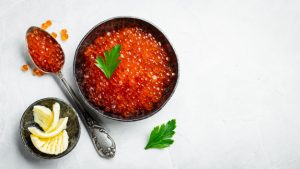
Caviar, although not everyone finds it fits for their taste buds, is still considered one of the most popular high-end delicacies around the world. Culinary experts continuously seek for the best quality caviar from many countries, and Russia has always been one of the biggest suppliers of this fish egg. The country seems to never lack of it and the people love consuming it. Is there a reason why Russians love caviar?
It is one of the oldest delicacies in Russia
Of course, people in the country have started to eat it long before this day. Having caught the fish, people tasted all the parts, including fish eggs, and, finding them completely edible, ate it with appetite. At first, caviar was eaten raw – without salt. People salted black caviar, though, because sturgeons have been living on Earth since the ancient time. In Russia, black caviar has been popular and loved for a long time, but Russians has only begun to eat red caviar relatively recently; from the late 19th to early 20th centuries.
At first, Russian fishermen threw caviar away
The expansion of the country to the Pacific Ocean in the 17th century, the construction of the railway and the settlement of land led to the development of the fishing industry. For a long time, Russian fishermen and merchants did not recognize salmon caviar to have a place on the table, so they simply threw it along with other waste when processing fish as an inedible product.
Moscow and St. Petersburg tried red caviar in 1899, and the public accepted it indifferently. But everything changed when a salting recipe appeared. Presumably, it was borrowed from the Astrakhan or Amur people. By that time, for a long time, the tribes already knew how to pickle sturgeon caviar. In just three or four years, red caviar had become popular not only in Russia, but also abroad. The Japanese, who also harvested red caviar, adopted the salting method and even the word itself from the Russians.
In 1908, salmon caviar, cooked in the Russian way, began to gain popularity. Prices had risen, and the volume of fishing had increased. And after the church declared that caviar was included as lean food and allowed to be eaten in fasting, sales of red caviar broke all records.
Russian love caviar, unlike other people around the world
In 2015, Russia harvested 375 thousand tons of Pacific salmon, and about the same amount was caught in the United States. True, Americans practically do not eat red caviar: once in Alaska they simply threw it away, then they fed the dogs with it, and then sold it to Japan. Russians who live in the United States often exchange information about from where they could buy freshly caught caviar.
In general, the main consumer of red caviar in the world is Russian. Most foreigners who tried caviar for the first time, either because having visited the country or in a restaurant of Russian cuisine abroad. So, if you want to surprise your foreign friends with this delicacy, try and consider this point first: according to statistics, one of every ten people who first tried caviar did not like its taste.
Surprisingly, caviar is not expensive in Russia
Consumption of red caviar for 12 months, from October 2018 to September 2019, increased by 22% compared to the previous same period, according to research company GfK, which tracks the daily purchases of 20 thousand households throughout Russia. The share of families that bought red caviar at least once a year increased by 3.5 percentage points, up to 33%. The Russians, as follows from GfK data, began to buy this product not only more often, but also more at a time.
The main reason why Russians began to eat red caviar more and more often is a reduction in prices for this delicacy, said Alexander Fomin, vice president of the Fish Association. Red caviar began to get cheaper in retail at the end of 2018, in December the price per 1 kg fell by 3.3% compared to December of the previous year and amounted to 3,768 rubles. Year-on-year price reductions continued and all nine months of 2019. The maximum drop occurred in July, when red caviar fell 10% year on year, to 3,594 rubles for 1 kg. In September, the decline in prices slowed down a little, but last month caviar in retail was still 9% less than a year earlier: 3,619 rubles for 1 kg.
In specialized retail, price reductions are not confirmed. At the peak of consumer demand, which lasts from September to the end of December, salmon caviar has traditionally risen in price which depends on the type of salmon. Chum salmon caviar now costs about 3,600–3,700 rubles in retail per 1 kg, pink salmon – from 3,300 to 4,000 rubles.
Fish products will always have a place on a Russian table
Russians generally eat a lot of meat. After a short survey in the streets of Moscow, it was found out that men prefer to eat cabbage soup and fried meat with boiled potatoes for lunch. Women most often called for borsch, dumplings and fritters with sour cream
Nevertheless, fish occupies an important place on the Russian table. In the shops you can find many types of sea fish – most often smoked or dried, less often raw. It is impossible not to mention caviar. Sturgeon and salmon roe is considered one of the natural resources of Russia. The main classification is, of course, red caviar and black caviar. However, this delicacy has many more varieties; black beluga or stellate sturgeon caviar is considered the noblest here, and red caviar is obtained from salmon fish. Still there is trout caviar, but Russians love it less. They serve caviar in different ways, most often as an addition to wheat pancakes or white bread and butter.
